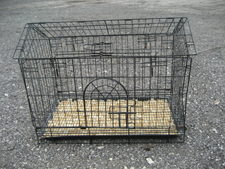
Reference Literature
The Domestic Rabbit
(Book; Section7)
The Rabbit
(Book; Chapter 6)
Texas Rabbit Manual
(Manual; pgs. 5-8)
Raising better rabbits & cavies
(ARBA Book; pgs. 75-88)
DID YOU KNOW...
Rabbit fecal pellets are an excellent source of organic nitrogen. If you mix the fecal pellets with dirt and some wood shavings you can use this mixture around plants as a natural fertilizer. If you have a compost pile, you can also add your rabbit pellets as an enriched natural nitrogen source for bacteria that will help speed up the decomposition process. You can learn more about this process in the Sustainable Agriculture lesson in the 4-H Market Rabbit Project.

Introduction
Before you buy a rabbit, you need a place to house your rabbit(s). The kind of building you choose depends on location, climate, and the monetary funds that you have available. Plan for housing in a way that will allow you to take care of your rabbit with minimum manual labor. Consider feeding, breeding, and handling of the rabbit(s), as well as cleaning of the hutch. Design the housing so that you can carry out these tasks easily.
So, Let’s Talk Hutch!
The first thing to consider is location, location, location. This will be essential in determining your hutch or cage design.
Indoor hutch
An indoor hutch can be used if you have one rabbit or a few neutered/spayed rabbits that can be kept in the same cage.
The indoor hutch needs a removable pan to contain the droppings.Outdoor hutch
An outdoor hutch is best for several rabbits that must be kept in separate cages, especially if they will be breeding. Droppings can fall through the floor, so no pan is needed, there is less odor and less cleaning.
Where To Place The Hutch
Once you have decided on an indoor or outdoor hutch, then you must decide the proper place to put the hutch.
Indoor hutch
The cage should not be directly below, above, or across conditioning vents or fans.Outdoor hutch
An outdoor hutch should be in a shady area, away from strong air drafts and from potential predators, such as dogs or cats. It should be in an area where there is a slight draft during hot weather. To find if an area has a slight draft, look at how the leaves move under a tree when there is a slight breeze. It will help you place your hutch so that it faces the draft.
